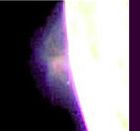holoscience.com | The ELECTRIC UNIVERSE®
A sound cosmology for the 21st century

NASA risks Galileo spacecraft by FLYING A “KITE” AT IO!
JPL News wrote: “Galileo makes two daring passes less than 620 km above Io on October 11 and November 25, 1999. In November Galileo might even pass through the plume of Pillan Patera, making it the first spacecraft ever to fly through an alien volcano.”
NASA scientists are upholding a long tradition of misinterpreting observations from their space probes. This time they are jeopardising one of their most successful missions. Long ago in 1979, when the so-called volcanoes of Io were first discovered, Professor Thomas Gold of Cornell University wrote that they are actually the site of powerful electric discharges. NASA geologists paid no attention.
Jupiter is still capable of hurling a few thunderbolts!
 “The biggest mystery about Io’s volcanoes is why they’re so hot,” says Bill Smythe, a co-investigator on JPL’s NIMS team. “At 1800 K, the vents are about 1/3 the temperature of the surface of the sun!“
“The biggest mystery about Io’s volcanoes is why they’re so hot,” says Bill Smythe, a co-investigator on JPL’s NIMS team. “At 1800 K, the vents are about 1/3 the temperature of the surface of the sun!“
The temperature measured by Galileo is an average based on the sharpest resolution of its instruments. If scientists are having difficulty explaining 1800 K, they are in for a shock when they get closer…
I predict that when seen close up the temperature of those hot spots will approach that of the Sun as they are both electric arcs. (Electric arcs create intensely hot spots.)
The plan to fly the Galileo spacecraft through the the plume of an Io volcano in November is therefore as foolhardy as flying a kite in an electrical storm. It is to be hoped that NASA will recognise the dangers in time to change their plan for November. That is, if Galileo survives the October flyby.
“Another thing we’ll be going for with these close-up flybys are high resolution pictures of the lava flows”, continued Smythe. “We really want to know what the shapes and edges of the flows look like because that can tell us a lot about the properties of the lava. On Earth lava flows form little side lobes, or extrusions that look like arms, feet and toes.”
 On the contrary, most of the dark patterns seen radiating from the crater in this image of the Marduk “volcano” are not lava flows. They have the shape of lightning scars on Earth and are caused by powerful currents streaking across the surface to satisfy the arc’s hunger for electric charge. They rip huge sinuous furrows in the soil and hurl it to either side to form levee banks and side lobes. The stubby side channels will be found to have rounded ends like those seen on Martian “rivers”.
On the contrary, most of the dark patterns seen radiating from the crater in this image of the Marduk “volcano” are not lava flows. They have the shape of lightning scars on Earth and are caused by powerful currents streaking across the surface to satisfy the arc’s hunger for electric charge. They rip huge sinuous furrows in the soil and hurl it to either side to form levee banks and side lobes. The stubby side channels will be found to have rounded ends like those seen on Martian “rivers”.
Credit: Closeup of an Io Volcano – NASA, Voyager Project, Copyright Calvin J. Hamilton